The Future of E-scooters: Oui ou Non?
& Inside:
Urban Flights: Getting Ready to Taxi












The Future of E-scooters: Oui ou Non?
Urban Flights: Getting Ready to Taxi











Future transport, as a concept, is by definition not one thing. For us at FTN it encompasses a broad spectrum of modes and technologies. For example, we cover new but fully working transport trends such as micromobility with the recent surges in e-bike sales and the advent of electric scooters. But we also cover transport technologies that are very much in their infancy and not yet in commercial operation, such as urban air mobility. The topics we cover will change as transport trends do and it will be interesting to observe how they develop over time. Will they in fact take off or will they fade into obscurity, replaced by the next big idea?
One area we look at in this magazine is the battery versus hydrogen debate (p.20). Will this end like the battle between Betamax and VHS with a total knock-out or will it look more like that between PlayStation and Xbox where both vie for market share alongside each other?
Another area that is currently much on the political agenda is that of e-scooters. Our feature writer Tiana May takes a look at this seemingly Marmite-esque mode of transport (p.6), following the recent referendum in Paris where the vast majority of voters voted to ban shared

e-scooters in the city. This particular vote and the on-going push for regulating e-scooter use through, e.g., geofencing highlights that transport and therefore future transport is not just about the vehicles themselves. They require the right infrastructure. And this in turn requires the political will. The roll-out of electric vehicle charging facilities has been widespread and rapid. Had there been the same political will to roll out dedicated, segregated infrastructure for pedal bikes, e-bikes and e-scooters, away from cars and pedestrians, the voters in Paris might have been less hostile.
On p.40 you can read Urban Flights: Getting Ready to Taxi, which explores the possibility of electric vertical take-off and landing (eVTOL) aircraft taking to our skies in the future. Where is the technology at and what legislation will be required?
To keep abreast of the latest developments in the transport sector as a whole, we like to go to events and exhibitions, talk with suppliers to learn about their perspective of the industry and listen to keynote speeches and panel discussions. For that reason we’ve chosen to feature Global Mobility Call in this issue (p.10), an event that will take place in Madrid later this year. Having attended the inaugural event last year, we’re looking forward to being back again in 2023. We look forward to exchanging ideas with everyone there!
Please enjoy our very first Future TransportNews e-magazine!
Our Railway-News magazine features the latest industry news across four categories: Track & Infrastructure, Rolling Stock, Services and Data & Monitoring. From condition monitoring and predictive maintenance to worksite protection and crew management, we have you covered.
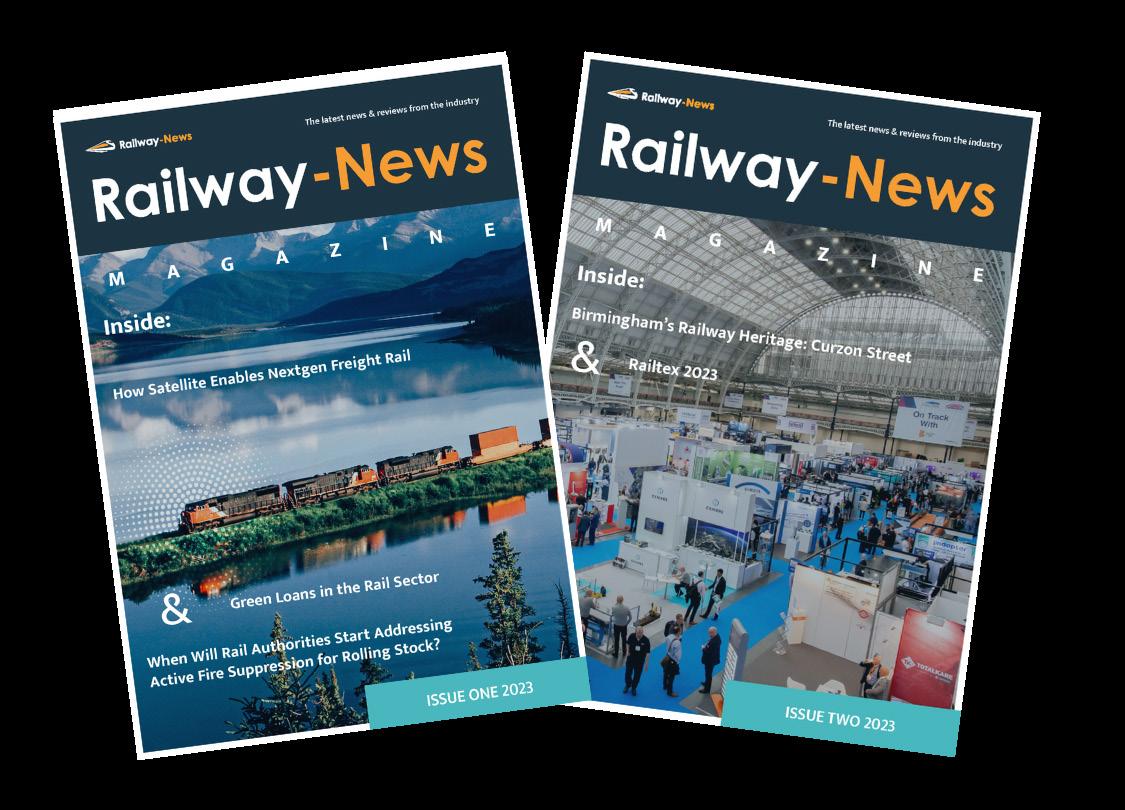
Read our Railway-News magazines
All the latest industry news and updates broken down in our directory categories which are: Digital Solutions, Bus Interiors & Design, Maintenance & Servicing, and Electrification & Power so you can easily find the items you’re most interested in. Plus much more!
Read our Bus-News magazines

Read our annual Airport Industry-News magazine to stay abreast with all the latest developments in the airport sector, from terminal and runway construction, passenger and baggage handling technology and decarbonisation to digitalisation, design and security.
Read our Airport Industry-News magazines

p.6 p.10 p.12 p.20 p.40 p.14 p.17 p.24 p.29 p.32 p.36 p.42 p.46
The Future of E-scooters: Oui ou Non?
Event Feature: Global Mobility Call
Upcoming Events 2023
E-mobility: A Stepping Stone?
Urban Flights: Getting Ready to Taxi

An Industry First: Wireless Charging Autonomous E-buses
Comeca Participates in 1st French Project Retrofitting Buses to Electric
The Power of 5G for the Connected Future
NEXCOM’s ATC 3540 and ATC 3750, Powered by NVIDIA® Jetson, Lead the Way in Transportation
Harness the Power of Your Data to Enable a New Vision for Multimodal Transportation
Increase Driver Satisfaction and Revenue Potential through Personalisation and Branding with Automotive OLED Technology
The Future Journey to Advanced Air Mobility
Following the recent referendum in Paris that saw voters choose to ban shared e-scooters in the city, the future of micromobility in Europe is a hot topic, with cities looking to evaluate whether e-scooters can be safely integrated into urban transport networks for the long-term future.

On 2 April 2023, residents of Paris had the opportunity to vote ‘For or against self-service scooters’. Of the 7.46% who voted, 89.03% opted to ban their use. Among those in favour of removing shared e-scooters from the city, safety was considered a key concern, as in 2022 e-scooters were involved in incidents that caused 459 injuries and three deaths in the city.
The industry is now yet to see how the results of this referendum may impact the acceptance of this mode of transport elsewhere in Europe, especially in countries such as the UK, where government regulations are still pending.
It is consequently likely that data evaluating e-scooter incidents will now be paramount in shaping regulatory decisions and public attitudes in the coming months.
In the UK, the most recent comprehensive Department for Transport (DfT) report revealed that the country saw 1,352 recorded collisions involving e-scooters throughout 2021. The report also indicated that 70% of people involved in these collisions did not require medical attention, and 82% of the collisions did not involve any other road users.
Overall, this data produced an estimated casualty rate of 13 casualties per million miles travelled by e-scooter. Compared to a rate of 3.9 for cyclists, this figure may suggest that e-scooters are significantly less safe than bikes, and their rollout should therefore be treated with more caution.
However, during this year’s Parliamentary Advisory Council for Transport Safety (PACTS) Spring Conference, George Beard, Head of New Mobility at the UK’s Transport Research Laboratory (TRL) highlighted that there are a number of important factors to consider that limit such a comparison.
For example, the novelty factor for e-scooters is likely to affect this casualty rate, as unlike bikes, they have not been embedded as a long-standing component of our transport network. This gives cyclists an upper hand, where riders are more practised and competent, having learned to ride from a young age, and other road users are more aware of their presence and behaviours.
George Beard, Head of New Mobility at TRL said: “We need to be careful when interpreting the data since
it’s not a like-for-like comparison in terms of that user experience.Indeed,self-reported incident data from user surveys in DfT’s evaluation shows that the inexperienced riders were much more likely to report having a collision than the experienced.”
As the widespread adoption of e-scooters remains a relatively new concept within our transport systems, the associated technologies and designs for these vehicles are also still developing to further improve their safety credentials for riders and the wider public.

The DfT’s research highlighted that the most commonly reported causes for e-scooter incidents included issues with the vehicles, such as the brakes not working; the way geofenced e-scooters behave, with sudden losses and returns of power; finding e-scooters unstable; and encountering slippery road surfaces.
As a result of such issues, many of these problems are now being tackled by shared e-scooter operators who continue to improve their vehicle designs to provide more stability, smoother acceleration and more effective pneumatic tyres for uneven and slippery surfaces.
“We need to be careful when interpreting the data since it’s not a like-for-like comparison in terms of that user experience.Indeed,self-reported incident data from user surveys in DfT’s evaluation shows that the inexperienced riders were much more likely to report having a collision than the experienced.”
George Beard, Head of New Mobility at TRLIn addition, operators are also working to improve safety for the wider public, such as through the development of a universal e-scooter sound to alert the visually impaired of their presence.
In light of these recent and upcoming developments, it would arguably be erroneous for more cities to ban shared e-scooters at a time when the industry is actively tackling and overcoming their associated safety concerns.

Furthermore, as much of this progress to improve the safety of e-scooter vehicles is specific to shared models rather than privately owned units, Paris’ decision to ban rental e-scooters could be counterproductive. Indeed, many Parisians who previously relied on shared e-scooters may be forced to shift to purchasing their own vehicles, which will not come with the same safety features and geofencing restrictions as the rental units.
Consequently, the outcome of Paris’ referendum is unfortunate and has the potential to negatively impact the future of urban transport. Instead of writing e-scooters off as an unsafe mode of transport, it would be more productive for the industry to continue working with national and local governments to ensure these vehicles can be safely implemented as part of our cities’ established transport systems.
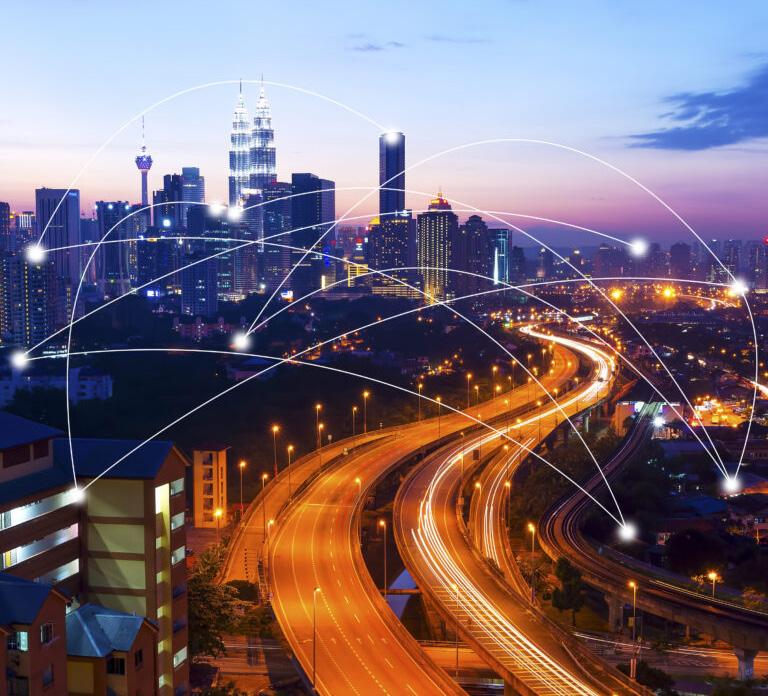


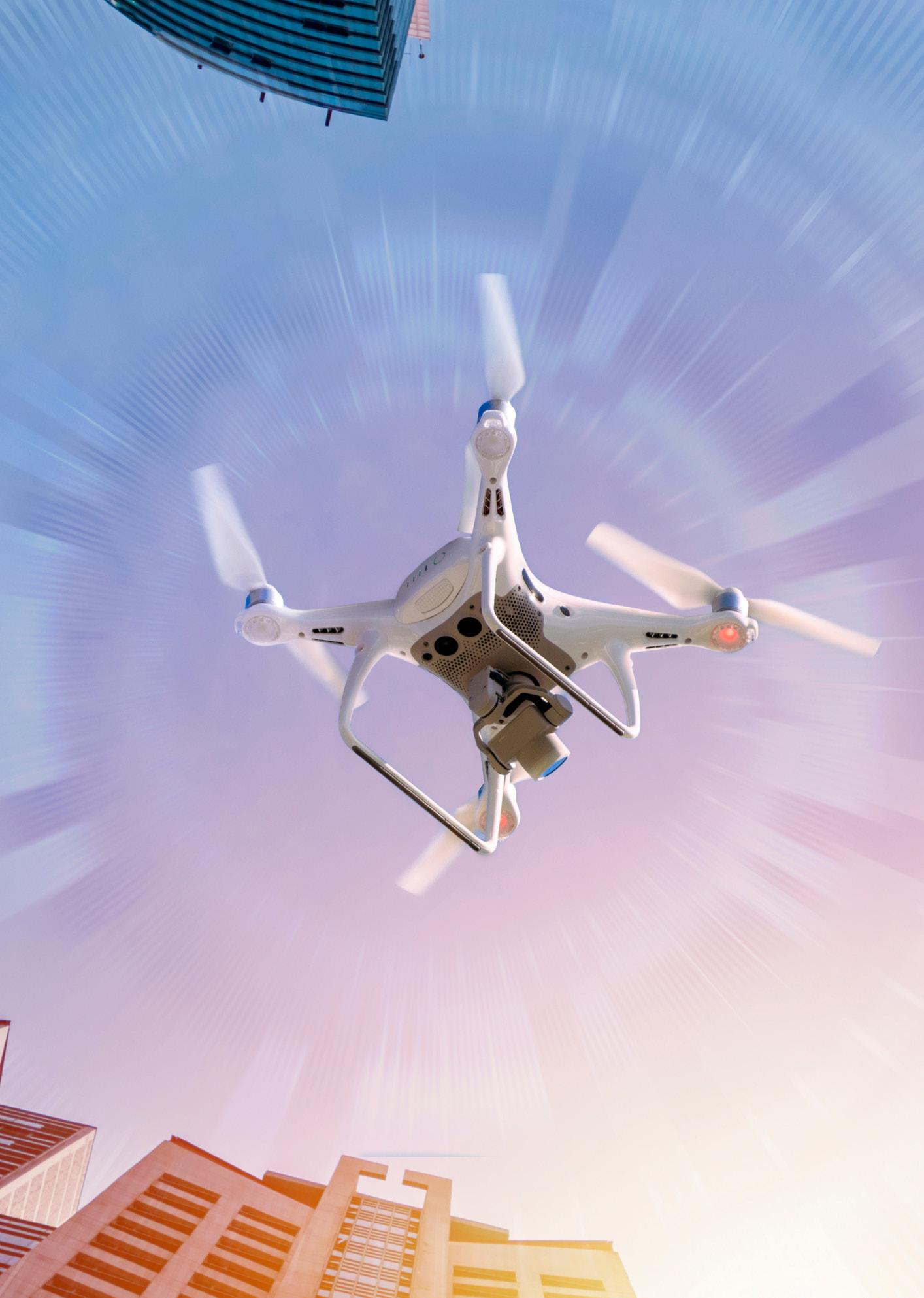
Where: Avda. del Partenón 5, Madrid, Spain
When: 12–14 September 2023
Organiser: IFEMA Madrid
Global Mobility Call is an international event held in Madrid, Spain, focusing on sustainable mobility for people and goods.

The 2023 edition will be held at IFEMA Madrid from 12-14 September and will bring together suppliers, city councils, institutions and administrations to help shape

transport, alongside more challenging industries such as aviation and maritime shipping.
In addition, the event will focus on improving the passenger experience through the rollout of digital technologies. For example, integrated ticketing, live travel-information displays and mobility-as-a-service (MaaS) apps can all make public transport more attractive in order to help shift people out of private cars and into more sustainable alternatives.
of mobility. This event, held within the framework of Global Mobility Call, aims to determine solutions to protect vulnerable users within our transport networks by applying new efficient transport models.
Exhibitors at Global Mobility Call will include companies from sectors focussed on energy, public transport, technology, and infrastructures, including Cespa, EMT and Metro de Madrid, Adif, Aena, Arriva, Iberia, Renfe, Ineco and the National Geographic Institute to name but a few. Information for companies wishing to exhibit can be found here.





Meanwhile, a comprehensive itinerary of keynote speakers and discursive debates will take place across multiple theatres. This will include the Main Auditorium, where a strategic agenda will tackle major topics regarding the future of transport, alongside three additional agoras for debates. This year’s speakers will include world leaders and politicians, company
CEOs and founders, researchers, and influencers, with the agenda scheduled to be announced later this month.
Global Mobility Call is sponsored by the Spanish Government through the Ministry of Transport, Mobility and Urban Agenda and has the support of the Community of Madrid and the City Council.
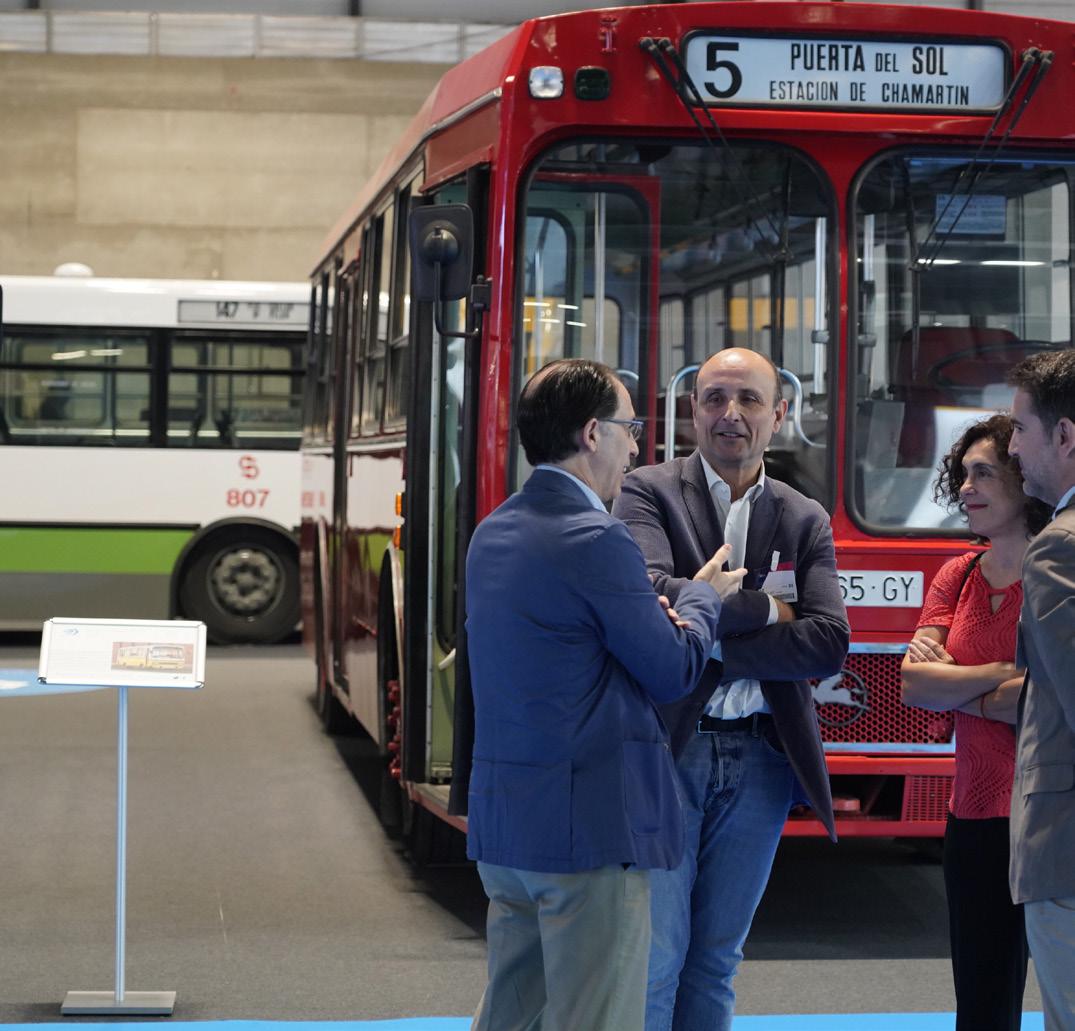

This year, the event also coincides with the Spanish Presidency of the European Union, which begins on 1 July 2023.
www.ifema.es/en/global-mobility-call

WiTricity
An Industry First: Wireless Charging Autonomous E-buses

Comeca

Comeca Participates in 1st French Project Retrofitting Buses to Electric
p.14
p.17
E-mobility: A Stepping Stone?
p.20


FromGeneva, Switzerland to Trikala, Greece and Kronach, Germany to Oslo, Norway, autonomous buses and shuttles can be found in cities around the world.
Although these electric buses are driverless, they still require someone to plug them in to charge – and unplug when done.
One innovative city is Zhengzhou, China where you’ll find driverless buses that also charge without human
assistance. These buses are a result of a unique collaboration between WiTricity, the pioneer in wireless charging for electric vehicles, and Yutong Bus, one of the world’s major bus and coach suppliers. This collaboration marks the first-ever commercial application of wireless charging for an autonomous electric bus, with WiTricity providing a key feature in one of the most advanced public transportation systems in the world. Yutong buses have been exported to over 30 countries and regions, with a market share of over 30% in mainland China and more than 15% worldwide.
“We are so excited to see this first real demonstration with Yutong Bus of wireless charging powering autonomy at scale,” said Alex Gruzen, CEO of WiTricity. “As autonomy progresses,the logistics of charging and servicing will become even more critical.WiTricity wireless EV charging can enable the next generation of electrified transportation and logistics.”
The commercial deployment of wireless charging in Yutong’s e-buses debuts in Zhengzhou, China, on the Xiaoyu 2.0 autonomous minibus. This level 4 autonomous bus seats ten passengers and has a range of 150km.

Wireless charging makes driving an electric vehicle easier, safer and more convenient than driving a plug-in vehicle. But, beyond this, full autonomy is not possible without wireless charging; it’s the perfect complement to predictable, repeated routes of municipal buses and airport shuttles. For instance, static wireless charging pads can be placed at the bus depot for end-of-shift charging or at locations where buses and shuttles
consistently stop for passenger pickup and drop off. While waiting for passengers to leave and new passengers to board, the vehicle can be charging – with no human intervention. This ability to provide charging throughout the day can help reduce the size of EV batteries and peak energy demand.
Safety is of utmost concern when it comes to fleets. Trips, slips and falls are the most common workplace injuries. With large, heavy charger cords at your employees’ feet, accidents are waiting to happen. Safer working conditions are realised by eliminating trip hazards and the need to wrangle these unwieldy cords and cables. And employees are happier not having to remember to plug in.
Bus and other commercial fleets can achieve a lower total cost of ownership of their electric cars, vans, buses and trucks with wireless charging. From reducing peak load and associated utility company demand charges with vehicle-to-grid (V2G) to build-out costs and reduced maintenance, fleets can maximise driver and vehicle uptime through more efficient wireless charging.
With wireless charging, drivers don’t need to worry if their vehicle isn’t charged due to the previous driver forgetting to plug in. Charging starts as soon as the vehicle is parked over the charging pad and stops when the vehicle is fully charged. One less thing to worry about at the end of a shift – or the beginning of one!
WiTricity is the leader in wireless charging, now focused on its fifth-generation solution. WiTricity’s automotive-grade wireless chargers have been tested by automotive OEMs and are proven safe, efficient and reliable. WiTricity’s patented magnetic resonance technology is the foundation of its overall solution. Its specially designed low-loss resonators allow high efficiency, while proprietary tuning technology enables efficient operation over a wide range of conditions.
WiTricity Halo™ chargers simplify the charging experience by removing the need to plug in. This is particularly significant as transit applications for autonomous shuttles and buses grow worldwide, wireless charging will play a key role in keeping those vehicles on the road.
Fleets, like Yutong Bus, rely on WiTricity’s design and architecture, which has been demonstrated to be the most efficient and interoperable system available. WiTricity worked tirelessly with the industry to develop the global standards that will drive interoperability: SAE International and IEC/ISO (International); DKE and Project STILLE (Germany); and the CEC and CATARC (China).
The result is a magically simple driver experience with advanced foreign object and living object detection to safely protect and disable charging should metal, hands or feet enter the charging area. The flexible system can charge vehicles from low-ground-clearance sports cars to medium-clearance sedans to high-ground-clearance SUVs, trucks, or buses – all with the single system design.
In addition to Yutong, WiTricity has seen the deployment of its wireless EV charging to date in passenger vehicles, including FAW’s HongQi and Genesis’s GV60. Taxi trials are also underway, showing off the use of wireless charging in queues to give the taxis ‘powersnacks™’ as they wait for their next fare. The Yutong buses are the first demonstration of wireless charging with autonomous commercial vehicles.

For more information contact Eric Cohen
eric.cohen@witricity.com
witricity.com
Watertown, MA, USA


The energy transition is a major challenge for our society, and more and more initiatives are emerging to reduce our impact on the environment. In this context, the Rouen Normandie metropolis has embarked on an ambitious project: retrofitting 49 Crossway internal combustion engine (ICE) buses into electric buses for school use.
To carry out this project, they have teamed up with some excellent partners, including Comeca, a specialist in ultra-fast charging and supplier of charging stations for the metropolis.
Comeca is a major player in mobility and was selected for its technological advancements in ultra-fast charging. Previously involved in projects to purchase new electric vehicles, Comeca is now participating in a project to convert gasoline vehicles to electric. This process, known as retrofitting, is an ecologically and financially attractive alternative for major French cities and beyond.

The Rouen Normandie metropolis has chosen to retrofit part of its existing bus fleet instead of buying new vehicles, reflecting its commitment to sustainable development.

Comeca, already a supplier of charging stations for the metropolis, is proud to participate in this French project alongside Greenmot, Forsee Power and SPL. With its design and production of recharge solutions in France, Comeca is a true local partner. This two-year project will be the first successful example of French collaboration in the field of retrofitting and energy transition.
Comeca is very pleased to renew its collaboration initiated in 2022 and to participate in this new project, which shows the Rouen Normandie metropolis’s commitment to sustainable development and energy transition.
Watch our video here
For more information contact:
Marion Birkel Sales Director Europe, Comeca Group
m.birkel@comeca-group.com www.comeca-group.com

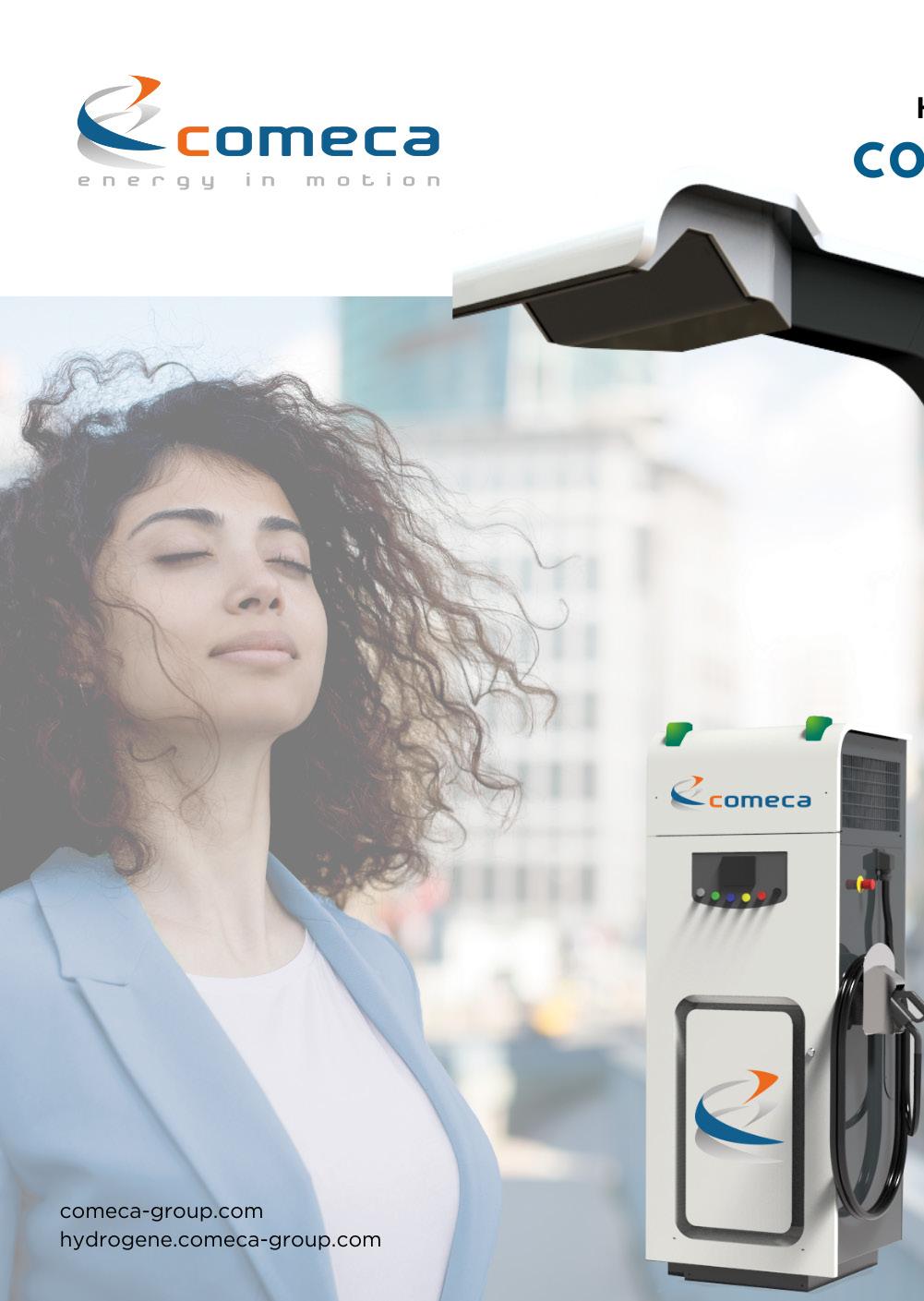

Governments around the world have allocated significant funds to invest in moving powered transport away from fossil fuels. Two main avenues are being explored: battery power and hydrogen fuel cells. Both of these technologies have different benefits and drawbacks, but in the automotive sector, batterypowered vehicles, the associated infrastructure and the underlying technology are more advanced.
However, as the rollout of electric vehicle infrastructure continues, some voices have suggested that it is merely a transition technology until hydrogen fuel cells can take over.

Two of the main drawbacks of battery technology for electric cars from a user perspective are range and charging time. The concern about range has even been given a name: range anxiety. Can I, the driver, complete my journey before finding and accessing suitable charging infrastructure? And then charging time: once
I find a charge point, I will have to spend a good chunk of time – 30–40 minutes maybe for small vehicles –waiting for the battery to recharge. Charging points where drivers are happy to spend a bit of time, e.g. at supermarkets or motorway service stations, make good sense as a result. However, the turnover per charger is low, much lower than that of a petrol pump.
The range of an electric car is not a concern for urban driving alone, especially not for those who are able to have a home charger installed, but here there has also been a great uptake of another electric vehicle – the e-bike. This is easily charged at home and because of the very low weight of the vehicle, the battery doesn’t have to work very hard to move the vehicle itself, compared to a car. If I am going to invest in an electric car, an expensive purchase, I would specifically want it to have at least the same capabilities as a conventional ICE car – I would want to take it on road trips without worrying how far I can go and without having to spend much of my travel time waiting for the battery to recharge. This is to say that range is more of a concern when recharging times are long.
Tesla Model 3 © Tesla
The advantage of hydrogen-powered cars is that they address both of these user concerns. The range and fuelling time for these vehicles is far superior. Refuelling a hydrogen-powered car takes around five minutes. Refuelling here could take place much as it does currently with diesel and petrol fuel, at service stations with a quick turnover. Consequently, there would not be a need to install a huge amount of street furniture on pavements throughout the country – in addition to removing street space from pedestrians, this also removes the option of protected infrastructure for electric and pedal-powered micromobility vehicles.
However, the obvious problem at the moment is that there are very few hydrogen refuelling stations in the
country (UK) – not even 15. And this paucity is not the only drawback. Consider the difference between a prominent electric vehicle – a Tesla Model 3 and a Toyota Mirai, one of the few hydrogen vehicles on the UK market. The Tesla Model 3 has a WLTP-certified range of 374 miles (602km) with an average range of between 60 (97km) and 395 miles (636km), while the Mirai has a range 400 miles (644km). The Tesla battery weighs 480kg, while the Mirai’s hydrogen tank weighs a mere 5.6kg, but this light weight does not mean small in size. The Mirai has three hydrogen tanks and since hydrogen is not a very dense fuel, these take up a lot of space and consequently room that could otherwise have been used for passengers or luggage. Incidentally, the space needed for the hydrogen tanks is a real limiting factor for a hydrogen car’s range. Compared to a mode of transport where this isn’t the case – trains – the difference in range between a battery and a hydrogen train is huge. A battery train has a range of around 80km, but a hydrogen train such as the Coradia iLint has a range of 600–800km!

So given that hydrogen cars seem to create as many problems as they solve, why do some people think battery cars are a mere stepping stone to our hydrogen-powered future?
Hydrogen fuel cells can be used not just for cars but also other modes of transport such as buses – and especially long-distance coaches – ships, planes,
Toyota Mirai © Toyotatrucks and trains. The challenge for battery-powered vehicles is long-haul operations and moving heavy goods and this is touted as one of the main use cases for hydrogen-powered vehicles. Aviation and shipping in particular come under the hard-to-electrify umbrella. In its hydrogen policy document, the EU says that “Batteries are a suitable technology for light-duty road vehicles or urban buses, but their lower energy density, compared to fossil fuels, limits their use for longdistance road transport, shipping or aviation. Clean hydrogen is a promising fuel for transport applications because it offers a higher driving range than batteries and quick refuelling. […] Clean hydrogen produced from renewable electricity and CO2 can also be used to produce synthetic gaseous or liquid transport fuels (Power-to-X). These so-called powerfuels can help decarbonise maritime shipping and aviation.”
In fact, Toyota, manufacturer of the aforementioned Mirai, is creating its Woven City, “a prototype city at the base of Mount Fuji [that] will offer a fully connected ecosystem powered solely by hydrogen fuel cells.”

One aspect of electric cars that has attracted attention of late is problems with the supply chain for certain critical minerals for the batteries. In its report Global Supply Chain of EV Batteries, the International Energy Agency (IEA) notes that “China produces three-quarters of all lithium-ion batteries and is home to 70% of production capacity for cathodes and 85% for anodes (both are key components of batteries). Over half of lithium, cobalt and graphite processing and refining
capacity is located in China. Europe is responsible for over one-quarter of global EV assembly, but it is home to very little of the supply chain apart from cobalt processing at 20%. The United States has an even smaller role in the global EV battery supply chain, with only 10% of EV production and 7% of battery production capacity.” To meet government targets for electric mobility, the report goes on to state that “Demand for EV batteries will increase from around 340GWh today to over 3500GWh by 2030…” and that “the supply of some minerals such as lithium would need to rise by up to one-third by 2030 to satisfy the pledges and announcements for EV batteries […]. For example, demand for lithium – the commodity with the largest projected demand-supply gap – is projected to increase sixfold to 500 kilotonnes by 2030 in the APS [the Announced Pledges Scenario], requiring the equivalent of 50 new average-sized mines.”
There are obviously problems with all power sources. Investment in these technologies will reduce these issues over time. And as with modes of transport where there is not one mode that is best for all journeys, the same can be said for fuel. Different power sources for different use cases. Vehicle manufacturers will invest in both technologies and consumers will consider the pros and cons for themselves, meaning we are likely to see a mix of power sources. Hydrogen-powered cars will likely increase in market share as the infrastructure becomes more established, but it does not seem likely they will replace electric cars.



Trains, planes, automobiles... they all move fast – their network should, too.
Transportation systems depend on a strong, secure network – drivers, passengers, employees and even autonomous operations all rely on it.
5G connectivity is key to unlocking next-gen transportation networks and applications. Given the critical importance of safety in the transportation ecosystem, in addition to ensuring a seamless user experience, having ubiquitous and extremely reliable connectivity is mission critical. Managing multi-access technologies such as public 5G, private 5G, and Wi-Fi will play a pivotal role in ensuring reliable and secure connectivity across transportation use cases.
Traditional networks forced data back to centralised nodes, which increased latency by being further away from where the data originated. With 5G, these nodes can now be decentralised and distributed in cloud deployments, bringing applications and the internet closer to the vehicle and allowing unprecedented lowlatency connectivity. Additionally, 5G provides improved security to aid car manufacturers and fleet managers to meet connected vehicle application security requirements.
The connected car has evolved since the early days of sending a signal once the vehicle was in an accident.

Today’s connected vehicle has become a bidirectional communicational channel. It needs to be able to communicate with the internet, other vehicles, roadways, intersections and more for traffic, safety and even entertainment use cases. Automotive OEMs must navigate how to seamlessly move a vehicle between environments, using multiple access technologies, and maintain network visibility, control and reporting.
Connected cars are the most sophisticated Internet of Things (IoT) devices today with use cases (onboard applications or services) ranging from notifying drivers of upcoming road hazards, emergency vehicles or pedestrians in intersections, to telematics services that enable predictive maintenance of vehicle components, infotainment services to enable audio and video streaming apps (Netflix, Spotify), on-board Wi-Fi, highdefinition maps and a marketplace for retail use cases.
In addition to these use cases, OEMs are looking at 5G as a critical enabler for autonomous driving with V2X services – where the car communicates with neighbouring vehicles, roadway infrastructure and an edge cloud – which requires periodic mapping updates and predictive intelligence with automated assurance to detect service anomalies and drive corrective actions. Additionally, software-defined vehicles require frequent software updates (FOTA/SOTA) which require reliable, high-bandwidth connectivity.
Webex integration is another application that OEMs are choosing to enable as a new service for their customers by making their vehicle a mobile connected office. Ford and Mercedes Benz AG’s recent partnerships with
Cisco to enable Webex Meetings and Calling in their vehicles pave the way for mainstream adoption by other OEMs.
Commercial vehicle (CV) OEMs are also leading adoption of autonomous trucking (AT) technologies and building homegrown fleet management solutions. Pervasive connectivity with edge deployments supporting mission critical V2X communications is a pre-requisite for CV OEMs to embrace autonomous trucking. Platooning, considered to be the first commercial AT application, is expected to generate TCO savings of ~45% by the end of this decade. Fleet
management solutions for electrified, autonomous trucks will subsequently leverage 5G connectivity for predictive diagnostics and maintenance of vehicle components and powertrain. Figure 1 has an overview of connected vehicle 5G-enhanced use-cases.

To achieve this vision of a 5G connected future in transportation, we are enabling vehicle OEMs to take the control needed to deliver a safer and more

sustainable fleet. That requires deep integration with networks and a deep understanding of the quality of service (QoS) that comes from it.
QoS becomes critical for services that depend on specific characteristics or SLAs like safety or autonomous driving. OEMs need to know how vehicles are performing, and to be able to address issues as they arise, not open a ticket with their communications service provider (CSP) and wait for a response. They need a framework where CSPs allow them certain control and configuration privileges, like applying a slice to a network service or deploying additional edge nodes when capacity dictates they are needed.
This level of control will allow OEMs to provide unique customer experiences, with a reliable QoS to deliver their services. The car becomes a digital extension of the passenger’s journey, whether it’s a privately owned vehicle or a shared mobility service. And this goes beyond the connected car.

OEMs and municipalities must work together to build intelligent systems that will power the connected roads and corridors. They must learn how to bring disparate

sources of data together, process them into intelligent decisions and then feed that information back to drivers or infrastructure that can act upon it.
The next generation of both cars and networks will change transportation and mobile networks in ways we can’t even fathom yet. But unless you have a strategy for how to bring these two together, you will struggle to unlock the power that is just at our fingertips.
Scott LantisCisco has a rich history of delivering exceptional transportation results worldwide. We’ve worked with over 32,000 transportation customers in 169 countries to help them transform operations and power inclusive, safe, efficient transportation for all.
Cisco portfolio for transportation: What can we help you solve today?

Between the future of transportation and the secure infrastructure that connects it, there’s a bridge.
Traffic Light Recognition
BlindSpotDetection
DetectionBlindSpot Detection

intrusion inspection Intrusion

IP67 Accelerated Edge AI In-vehicle/Railway Computer

■ Built-in NVIDIA® Jetson Orin™ NX SOM
■ Compact and fanless design

ATC 3750-6C/3750-A6CR
Accelerated Edge AI In-vehicle/Railway Computer
■ Built-in NVIDIA® Jetson AGX Orin™ SOM
■ Designed with rugged, compact and hybrid thermal solutions
9F, No.920, Zhongzheng Rd., Zhonghe District, New Taipei City, 23586, Taiwan, R.O.C..
www.nexcom.com
For more info., please contact:
mcsinfo@nexcom.com.tw
Thetransportation industry has undergone rapid transformation since the rise of artificial intelligence (AI), which has significantly enhanced efficiency and safety.


To keep up with this trend, NEXCOM Mobile Computing Solutions is proud to introduce its ATC 3540 and ATC 3750 series. These solutions represent the company’s leading-edge in-vehicle and railway edge AI platforms, offering enhanced driving aids across various applications in transportation including on-road safety, law enforcement, material handling and machine vision applications. Powerful AI inference accelerators are vital to meet the complex and real-time computing requirements of these tasks. The ATC 3540 and ATC 3750 series, which are based on NVIDIA® Jetson Orin™
NX and NVIDIA® Jetson AGX Orin™, respectively, provide powerful edge AI computing capabilities, and real-time data transmissions via 5G, Wi-Fi 5/6, and 10GbE to lower TCO and reduce risks in numerous transportation applications.
Before the emergence of NVIDIA® AI inference accelerators, computing especially for high-speed applications faced several limitations. One of the major limitations was the processing power of the central processing units, which were primarily designed for sequential processing. As a result, complex applications requiring parallel processing, such as AI and machine learning, were time-consuming and resource-intensive. Another limitation was the memory capacity of computers, which restricted the amount of data that could be processed at any given time. Additionally, the high cost of computing hardware and software
limited access to computing resources, hindering the development of new applications and technologies.
With AI recognition-assisted core technology rapidly maturing, the trend towards developing automatic train driving is becoming increasingly inevitable. However, ensuring the safety of drivers and passengers is of utmost importance. To achieve this, it is crucial to quickly provide backup and integrate AI recognition with multiple sensors for edge AI computers, in addition to the existing automatic train protection / operation system (ATP/ATO), under the highest safety integration specification SIL-4. This will help minimise the risk of potential accidents and meet the urgent demand for enhanced safety measures. By leveraging NVIDIA’s® technology, NEXCOM’s telematics computers can handle such complex computing tasks while maintaining a compact form factor, making it easy to integrate into various transportation systems. The adoption of NVIDIA’s® trend has led to the development of more advanced and efficient telematics computers, driving innovation and technological advancement in the transportation industry for rail safety applications such as pantograph inspection and track obstacle assessment.
The ATC 3540 is a compact, fanless mobile computer featuring the NVIDIA® Jetson Orin™ NX AI inference accelerator for high-performance AI workloads.
Delivering up to 100 TOPS, it is ideal for on-board or roadside civil enforcement, off-highway vehicle assistive driving systems, automated digital inspection systems for vehicles and factory automation. With its wide temperature range of -30°C to 70°C and an IP67 rating, the ATC 3540 is an excellent choice for deployment in harsh environmental conditions.

In contrast, the ATC 3750 is a robust vehicle computer featuring the NVIDIA® Jetson AGX Orin™ AI inference accelerator, making it a top choice for complex computing and AI operations. It can process up to 200/275 TOPS, offers 6x GbE PoE+ and an optional 10GbE for peripheral connectivity and high-speed data transmission respectively. With a wide operating temperature range of -20°C to 70°C and strong decoding ability of up to 7x 4Kp30, it has the capability to provide accurate AI inference and fast response times, making it suitable for safety applications including collision avoidance in harsh environments.
The ATC 3750 and ATC 3540 mobile computers minimise expenses through rapidly detecting real-time information using IP cameras, mmWave radar, or lidars, achieving blind-spot monitoring and licence plate and face recognition for criminal and civil enforcement. Pairing with stereo cameras, they can detect and estimate ambulance speed, helping open a pathway of green traffic lights for the fastest route.
NEXCOM’s mobile computers are versatile tools with an ultra-speed NVMe PCIe4.0 x4 SSD, enabling highspeed data transmission for real-time updates from the central control system and AI inference enhancement through cloud service providers with 5G NR and WiFi 6/6E modules. These computers offer ADAS of SAE Level-2 and 3 partial automation in restricted areas including logistics, ports, mines, rolling stock, etc., reducing drivers’ fatigue through increased vehicle assistance and safety features.
At NEXCOM, we provide software service support for NVIDIA® Jetson devices, encompassing an operating system (OS) image Ubuntu 20.04 backed by Linux kernel 5.10 and integrating the most up-to-date NVIDIA® Jetpack software. We develop the bootloader and perform the porting of the OS image, ensuring that it is equipped with the necessary peripheral input / output (I/O) functionality and pre-approved communication modules to facilitate seamless development of solution applications by developers. Additionally, NEXCOM’s software support further extends to on-board MCU, facilitating with API, sample code and I/O utility efficiency, and enabling developers to control the hardware effectively.

NEXCOM offers railway SKUs for both the ATC 3540 and ATC 3750 by adding an optional power isolation kit VTK PWA series to offer complete power protection and meet criteria in rail industry. The ATC 3750-A6CR is EN 50155 (OT4) certified and features an M12 X-coded connector, which prevents wire detachment due to long-term shaking. Moreover, the unique optional fan kit design can be easily installed in two steps to provide powerful heat dissipation, enabling it to operate in harsh environments with a wider operating temperature range.
The ATC 3540 and ATC 3750 rail edition are suitable for driver assistive applications as advisory systems that are perfect for smart transportation. With their high-speed data processing, efficient operations and superb connectivity, they offer features such as rough terrain recognition for real-time obstacle detection and collision avoidance. These railway computers help with object detection and eliminate blind spots, which is especially crucial in environments without
railway fences where unpredictable obstacles such as animals can enter the railway. Warning systems like these detect and warn operators, minimising accidents, damages, deaths and delays, while maintaining transportation volume and revenue.
The ATC 3540 and ATC 3750 are game-changing invehicle and railway computers that have revolutionised the transportation industry by providing efficient, cost-effective, and safe solutions. Both NVIDIA® Jetson Orin™ NX and NVIDIA® Jetson AGX Orin™ AI inference accelerators assist in delivering high-performance AI workloads, improved reliability and safety, making them ideal for a wide range of applications in smart city development and factory automation. With their durability, longevity, hybrid cooling solution, NEXCOM’s thermal know-how and efficient customisation service, both systems can be widely adopted across numerous vertical markets, setting new standards for innovation and technological advancement in the transportation sector.


Passenger and freight activity will more than double within the next 25 years, based on current data projections and macro trends.

Such projected growth is suggestive of demographics, urbanisation and social and economic progress. This increase will result in a significant growth in energy demand and carbon emissions. These challenges are compounded by economic pressures, resource constraints and competition between and combinations of various modes of transportation ranging from user-
friendly bicycles to high-speed transit systems. This need for change and smart mobility must be viewed not only through the lens of new capital projects but also by making more efficient use of the existing transport infrastructure already in place.
If we want a future of hope for society, that is sustainable, reliable, and efficient, we must develop transportation systems that optimise operational performance while also being kind to our natural built environment. We must be radically harnessing data capabilities and making full use of connected infrastructure opportunities.
The reality is that this transformation is already happening and gaining momentum. Cohesive already enables customers to operate different outcome-driven business models that support both our economic, social and natural built environments. The promise of a future with shared digital twins, connected networks and artificial intelligence is already creating a seismic shift that will put transportation users at the heart of the decision-making process.
Rennie Chadwick, Director of our Transport Business sets out how Cohesive enables integrated and intelligent transport networks which pervasively measure operational performance and monitor the health of physical assets.

My first engagement with the railways was back in 2000, when I worked with Railtrack as it was known then, to develop their Structures Condition Marking Index. The primary objective was to transform a subjective and qualitative assessment into a consistent, objective one, with a quantitative output. As a result, digital photographs and a relational database for inspection findings transformed Railtrack’s bridge inspection procedure.
Fast forward to the current day and things have continued to evolve, with increasingly sophisticated data capture methods. For example, using UAVs (unmanned aerial vehicles) for large-scale lidar (light detection and ranging), edge computing, and IoT (Internet of Things) for continuous monitoring and
alarms of critical assets, and even robot-mounted devices to access areas too risky for human beings. The challenge today is not so much how to capture digital data, but how to put that data to use, supporting decisions that make the lives of owners, operators and users of transport infrastructure, simpler and better.
Throughout the entire asset lifecycle, Cohesive focuses on helping our clients extract more value from their data. One of the common problems we encounter is a lack of visibility of the data an organisation has, i.e., the people that need to use the data, don’t always know what is available. This lack of visibility is then often compounded by a lack of trust: if users don’t know the provenance of the data, or don’t have some assurance as to its quality, they tend to ignore it and go and capture a set of data specific to their needs. This builds a patchwork of data over time, compounding visibility and data-quality issues and increasing operational costs.
Our approach is to help organisations build their data management strategy to match their business needs, now and for the future. This might be as straightforward as implementing a new asset management solution, or it could extend to defining and implementing a full digital twin capability.
Either way, the basics still apply, we need to work with our client to:
• establish clarity around their objectives, now and in the future
• understand the organisational design, now and for the future
• identify the data required to support the decisionmaking that helps achieve these objectives
• design processes and technology solutions that make it as easy as possible for decision-makers, everywhere in the organisation, to access the right data
If we want a future of hope for society,that is sustainable, reliable, and efficient, we must develop transportation systems that optimise operational performance while also being kind to our natural built environment.
• design a change programme that meets their needs
Consumers of transport networks increasingly expect to have access to information that fully informs their travel decisions from the perspective of the asset owner. This information is expected to cover doorto-door, not just discrete train, tram or bus services. Travellers want to know what their options are and what the impact of their decisions are (for example, how is this contributing to my personal carbon footprint, what are the costs, how long will it take, or what impact will the weather have?) across all the possible modes of transport.
Commercial models must keep pace with this new multi-modal transportation vision. Hoping for exciting, innovative outcomes when we are still procuring projects and services the way we always have is unlikely to yield the desired results.
Cohesive has been vigilant to ensure that all areas of the supply chain can interact with this intelligent transport network through the provision of common data environments and visualisations which enable the outputs to be the key target and therefore assimilate modern technologies and methodologies during this journey.
Understanding future operating aspirations at an early stage ensures that decisions are made early in the process to enable future innovation.
Solving problems like these is what computers excel at. What they need, to do this effectively, is quality data. Quality data is a consequence of a robust, welldesigned and well-executed data strategy.
Cohesive has been vigilant to ensure that all areas of the supply chain can interact with this intelligent transport network through the provision of common data environments and visualisations which enable the outputs to be the key target and therefore assimilate modern technologies and methodologies during this journey.

Does this leave the human component out of a job?
Far from it.
Our role is to use the outputs, together with our innate creativity, to continue to improve the way we deliver transport solutions, now and into the future.
Ask us how: www.cohesivegroup.com
For more information contact:
Rennie Chadwick Director of Transportation+44 7816 514412

rennie.chadwick@cohesivegroup.com
www.cohesivegroup.com


Branding is a crucial design element in the competitive automotive industry, where customers have a wide range of vehicle options.
Strong branding and offering customers the option to personalise their vehicles can help differentiate a carmaker. Lighting has a long history of creating iconic brand recognition, and with OLED lighting the potential for branding and personalisation through lighting is unmatched.
A strong brand can help an automaker demonstrate its unique design in a competitive marketplace, reinforce its perception of quality and reliability, and build customer loyalty. Personalisation can further this perception by allowing customers to craft their unique relationship with the vehicle and have a better user experience. These factors help justify the price tags for the consumer and will ultimately increase sales and revenue.
“As customers, we like to hear the word ‘custom’ because it makes it feel like our individuality is being recognised and we are given something tailored uniquely for us,” says Dave DeJoy, OLEDWorks CEO. “Carmakers have offered a choice between different paint colours,seating materials and technology options for years.Now,imagine custom lighting options that can be easily adjusted at any time with the simple press of a button.”


Organic Light Emitting Diodes (OLEDs) offer expanded branding and personalisation through high-contrast segmentation, flexible panel designs, and dynamic animation sequences. Unlike LEDs and traditional light sources, OLEDs have naturally uniform emission across the panel’s surface, allowing individually addressable segments to be included directly into the panel design.
This segmentation allows OLEDs to create dynamic animations and symbols for communication elements
 Flexible OLED lighting for automotive applications
Flexible OLED lighting for automotive applications
or branding. OEMs can also use high-contrast OLEDs to illuminate the model name for extra impact or add custom animations to rear lighting that distinguish their brand from competitors.
Another aspect of OLED lighting that can elevate your branding potential is flexible OLED lighting panels. With all the benefits of rigid OLED lighting, a flexible glass substrate allows OLEDs to conform to the natural architecture of the vehicle. Panels can match the natural curves of the car, creating a seamless lighting experience integrated into the overall vehicle design.

Rear OLED illumination can be even more impactful for branding at night. According to research by the National Safety Council, about 25% of our driving is at night. When drivers cannot see traditional design elements because of the dark environment or blinding oncoming headlights, rear lighting is one of the only areas of the car that can take advantage of unique branding and design elements in the dark. Why not include your illuminated logo on the rear of the car? This simple addition will help potential customers know what brand they are admiring at a glance. If carmakers do not adopt branded lighting elements, they could miss out on a quarter of their brand exposure potential.
Beyond brand-specific lighting, lighting also increases the options for personalisation of the vehicle and can
even open new revenue streams for businesses. Before now, if you wanted new rear lights, it involved switching the entire lighting unit and could require the work of a mechanic. But with the digitalisation of lighting and OLED segmentation capabilities, changing your lighting could be as easy as hitting a button.
Jeff Spindler, Director of Research & Development at OLEDWorks said, “With the immediate response that lighting provides,you can easily change the entire feel and look of your car with personalised lighting signatures or animations.Coming home animations, start-up animations,or just the standard look of the light could all be adjusted for specific drivers – even within the same vehicle.”
OLED lighting already offers custom lighting signatures through the Audi A8, which features OLED lighting technology by OLEDWorks. This model range includes four lighting signatures programmable to the user’s preference via the dashboard console. But personalised lighting can go further.
As OLED segmentation increases, there is no theoretical limit to the number of custom signatures possible. The push of software updates to cars over wireless networks also opens the door for new revenue models for carmakers. Vehicles in the future may come with three or four standard signatures for drivers. If they want more options, drivers can pay a fee to download a new signature they like or subscribe for monthly access to a digital library of lighting signatures and animations. And with an OEM-designed smartphone app, different drivers can easily switch between their preferred lighting designs.
As lighting technology advances, branding, and personalisation expand along with it. OLED lighting is increasing the potential for automotive manufacturers to set themselves apart in a competitive market and offer value to their drivers and stakeholders.
For more information contact Kathleen Miller
www.oledworks.com
marketing@oledworks.com
Segmented OLED lighting for communication and branding
p.40

p.42
The future of air transport is almost here. Situational Intelligence™ will soon herald its arrival.

Jaunt Air Mobility
Journey to Advanced Air Mobility
p.46
As manufacturers continue to make progress in producing electric vertical take-off and landing (eVTOL) aircraft, these vehicles are expected to start delivering passenger taxi services over the next decade.
Although most eVTOL aircraft are still pre-certification, several manufacturers, including Archer Aviation, BETA Technologies, Eviation, Joby Aviation, Lilium, Volocopter, Wisk Aero and ZeroAvia successfully flew prototype models in 2022. Propelling this success, McKinsey’s Center for Future Mobility reported that 3 billion USD was invested in future air mobility technologies last year and over 6,700 orders were placed, representing 45 billion USD in value.

The majority of these orders came from airlines (25%), aircraft charter companies (16%) and leasing companies (14%), and although many agreements are currently conditional and non-binding, this early interest indicates significant future demand.
To integrate these new aircraft into our transport networks, flight paths will have to be safely established to segregate them from existing air traffic and other upcoming developments such as autonomous delivery drones.
In the US, the Federal Aviation Administration (FAA) is preempting this need and recently released an updated airspace blueprint for future air taxis. This blueprint will allow early eVTOL operations to use existing routes and infrastructure to fly much as helicopters do today.
However, as the number of operations increases, new corridors with multiple flows of aircraft will need to be introduced, and the FAA recognises that evolving technologies such as aircraft automation and realtime data sharing between aircraft will be needed to effectively and safely manage these corridors.
In addition, dedicated infrastructure with high-voltage electricity networks and reliable charging points, as well as appropriate passenger amenities, will be needed to get a significant number of electric aircraft off the ground in a commercial setting.
In response to this need, companies such as Ferrovial, Urban-Air Port and Skyports are working to design facilities to enable efficient operations. This includes amending existing vertiports to accommodate eVTOL aircraft as well as building a network of new facilities to provide more extensive connectivity.

For example, Archer Aviation and United Airlines have announced that their first commercial eVTOL route is to operate between Newark Liberty International Airport (EWR) and New York City’s Downtown Manhattan Heliport from 2025. This will involve investing in charging and parking infrastructure at the existing facilities and installing advanced software to manage eVTOL operations.

On the other hand, in April 2022, Urban-Air Port demonstrated a prototype vertiport in Coventry, UK to demonstrate the potential of dedicated eVTOL sites. The facility included all elements of an airport such as check-in, security and retail areas, as well as infrastructure for air traffic control, charging and

maintenance combined within a physical footprint that was 60% smaller than a typical heliport. The site can now be replicated elsewhere at ground level, on water and on rooftops within future eVTOL networks.
With significant developments thus underway both on the ground and on the aircraft, the future of urban air mobility appears forthcoming. In light of this progress, select routes are expected to commence passenger services in the next few years, allowing travellers to avoid road traffic congestion without producing tailpipe emissions.
© Foster + Partners
The future of air transport is almost here. Situational Intelligence™ will soon herald its arrival.
Beyond just situational awareness, Situational Intelligence is the ability of a machine to understand and make sense of the current flight environment and then to anticipate and react to threats to flight safety. Put another way, it’s a computer able to sense, analyse and respond to environmental situations – just like a human pilot does. But better.
In the near term, Situational Intelligence will provide indispensable pilot assistance in the fundamentals of flying, conveying to the pilot answers to three essential questions:
Where am I?
Where can I fly?
Where can I land?
One day soon, Situational Intelligence will act upon the answers to these questions enabling aircraft to fly autonomously, always with a human in control, but, quite possibly, without the need for human intervention.

Situational Intelligence will usher in a new era enabling all air transport to reach safety levels now possible only for the heavy infrastructure-burdened airlines and airports. The dream of air taxis and flying cars is now emerging from imagination as the new reality where
distance and division are easily overcome. At scale, movement about the planet will be more accessible, providing more opportunity and equity to all.
Coined by Daedalean, the leading software and hardware developer of pilotless flight, the term Situational Intelligence is made possible by a new level of flight control algorithms resulting from recent developments in artificial intelligence, or, more accurately, machine learning.
“Machine learning is central to our work in providing intelligent cockpit systems,” says Luuk van Dijk, who founded Daedalean in 2016 along with Anna Chernova. “It’s a more specific term than the much bandied about ‘AI’.Machine learning is,basically,training systems to learn to do a task without being explicitly programmed to do that task. We train a machine in the lab, for example,to recognise a runway so that it can recognise runways out in the world in real life.”
Out in the world, a live stream of video footage from cameras mounted on the exterior of an aircraft is fed to an onboard computer, which interprets and categorises in real time the various objects it detects: mountains, clouds, lakes, rivers, aircraft (and even specific aircraft types), masts, cranes, wires hanging between utility poles and, of course, runways, and for a rotorcraft –flat, clear areas that could serve as emergency landing options.
At the moment, video footage from the cameras is the only information the onboard computer processes.
“We based the initial version of our system solely on computer vision,” says van Dijk. “We chose to start with visual information because compared to other sensors like radar and lidar,training a machine to identify specific objects is the hardest function to design in the whole system.And visual information is the most useful – there is nothing more fundamental to flight than looking out the cockpit window to figure out where you are,where you can fly,and where you can land.With onboard computer and cameras,our system can do just that.”
The first product to implement Daedalean’s technology is about to hit the market. In a joint partnership, Daedalean and Avidyne Corporation, a well-established US-based provider of integrated avionics systems, flight displays and safety systems for general aviation and business aircraft, are developing, manufacturing and certifying the Avidyne PilotEye™ Visual System.
It is poised to become later this year the world’s first certified machine learning application for a safetycritical case for civil aviation.

While the current version of PilotEye is capable of providing traffic detection, future versions will extend to the full suite of situational awareness functions, acquiring positioning and landing guidance as well – all based solely on visual data from the onboard cameras. And on Daedalean’s roadmap, the next generation of the system will incorporate additional sensors to create a complete picture of situational awareness.
The next step forward expands the potential of AI to react to environmental conditions and anticipate problems. That is how Situational Intelligence is going to change the role of a human pilot – from managing all risk to overseeing a system that automates risk management. Aircraft will share data to create a web of information aloft. When aircraft inform each other about real-time conditions in the sky, co-ordinate their movements and intentions and report to each other on
observed threats to safety, the flight will be safer and a massive scale-up will be possible. At scale, the benefits to humankind are limitless.
Transportation has a long history of improving human civilisation by expanding opportunity, quality of life and cross-cultural understanding. And while much recent
attention has been focused on air taxis that promise to whisk passengers across town from gleaming vertiports capping downtown skyscrapers, the promise of Situational Intelligence goes well beyond the urban core and ultra-frenzied professionals fighting for time savings at any cost. Here are just some of the use cases to benefit:
• One of the most important missions in all of aviation is emergency response, yet helicopter emergency medical service, or HEMS, continues to suffer among the most serious accident and fatality rates resulting from, for example, controlled flight into terrain, collisions with drones and birds and dangers at uncontrolled landing sites. Having a digital co-pilot in the cockpit would help the mostly single-pilot HEMS operations avoid these outcomes and allow the pilot’s attention to focus on the rescue mission at hand.

• When humanitarian crises break out, time and cost are the two key factors in alleviating wide-scale human suffering. Fleets of low-cost, life-saving autonomous aircraft could be quickly deployed, preventing the increase of devastation that can compound if aid is not delivered immediately.
• In our rapidly globalising world, ever-decreasing areas of untouched and fragile ecosystems continue to be threatened by traditional modes of access – whether road, rail or airport-dependent
 In the near future,traffic will be detected and categorised by an onboard computer analysing video from aircraft-mounted cameras
In the near future,traffic will be detected and categorised by an onboard computer analysing video from aircraft-mounted cameras
aircraft. But small, personal, electric rotorcraft would deliver visitors and ferry local inhabitants alike without needing to default to traditional development’s destructive footprint.
• A less obvious but still significant consequence of the widespread adoption of low-cost, accessible air transportation may be its impact on freedom itself. Many rural, isolated, off-grid communities as well as under-resourced urban neighbourhoods suffer from a lack of access to healthcare options, educational possibilities and professional opportunities precisely because of their geographical segregation. If transportation were no longer an impediment, services could be rendered to (not to mention contributions to society made by) people who just happen to live in a certain community.
• Although we currently enjoy overnight-everythingdelivery, we still can’t ship time-sensitive cargo directly point-to-point at a price affordable to a broad segment of consumers. What might a world of low-cost, direct delivery look like? What would you want to send to, or receive from, far-off lands? Something from your favourite market back home? A chilled bottle from that rural microbrewery? Fresh farm-to-your-kitchen table fare? Or maybe your homesick soul has a hankering for grandma’s apple pie. What if it could be delivered straight to you, almost piping hot?

The future of air transport is almost here. Situational Intelligence will help make the skies safer and the cost


“We chose to start with visual information because compared to other sensors like radar and lidar, training a machine to identify specific objects is the hardest function to design in the whole system.”
of traversing them lower. Machines are now learning how to fly better so that pilots can better accomplish their missions, cargo can quickly and cost-effectively reach its destination, and all people can more easily connect with resources and one another.
Urban Air Mobility
Entering into advanced air mobility (AAM), the design of the Jaunt Journey brings the proven SRC (slowed rotor compound) technology to market with a certification path as a rotorcraft.
“Jaunt allows me to come at rotorcraft from a new angle and deal with some of the problems associated with traditional rotorcraft,” says Martin Peryea, SVP and GM of Electric Air Mobility, Jaunt Air Mobility, an AIRO Group Company. “Today’s helicopters are welldeveloped designs and do one mission particularly well: vertical lift and hover. This limitation of traditional rotorcraft has been known in the industry for years. Most companies are now researching and developing compound VTOL aircraft.A compound VTOL aircraft like our Jaunt aircraft retains hover and low-speed capabilities and can take off and land vertically,then fly efficiently like a conventional airplane.We are also addressing other characteristics associated with traditional rotorcraft,such as noise and improved safety,which are critical for urban air mobility and public acceptance.”
Jaunt’s proprietary SRC technology allows the aircraft to land via autorotation or by gliding in a controlled fashion should there be an unexpected total loss of propulsion. The pilot can choose a safe landing spot and completely control the aircraft during descent. No ballistic parachute is required.

Continuing to take a slightly different path to commercialisation, Jaunt Air Mobility merged with AIRO Group Holdings, Inc. in 2022. AIRO announced its merger with a SPAC with Kernel Group Holdings (NASDAQ: KRNLU) earlier this year. The organisation is positioning itself as a new middle-market aerospace and defence sector company operating in four key divisions:
• Advanced avionics: highly critical electronic systems used in aircraft. Application areas include communications, navigation, monitoring, flightcontrol systems, artificial intelligence, collisionavoidance systems, radar and electro-optics.
• Electric air mobility: eVTOL (electric vertical takeoff & landing) aircraft. Application areas include air taxi, cargo, emergency services, commercial and military.

• Uncrewed air systems: UAS platforms and services for civilian/commercial and military applications. Application areas include reconnaissance, attack, surveillance, inspection, weather analysis and healthcare.

• Training: professional and military aviation training for clients within the wider A&D sector. Application areas include customer-specific solutions, close air support, aircraft leasing, ab initio pilot training and training or aviation consulting services.
The company plans to design and manufacture the Jaunt aircraft in Montréal, Canada, and will work with
Transport Canada for certification. “We are working closely with the aerospace sector,whose technical expertise is known globally and with the federal and provincial governments,” says Eric Côté, President of Jaunt Canada.
Jaunt Air Mobility now has customers in North America, Central America, South America, Europe and Asia. “Working with each customer brings its own regional needs and requirements,” says Jaunt’s Chief Commercial Officer Simon Briceno. “For example,the Jaunt Journey can improve the transportation needs of highly congested cities such as in India and Mexico.Our aircraft can also operate at high altitudes to meet the performance demands in places like Mexico City.”
Beyond Jaunt’s AAM customers, the team was awarded several contracts under the AFWERX Air Force programme. Studies conducted with Penn State and Continuum Dynamics, Inc. employed novel acoustic analysis techniques to develop and characterise noise from Jaunt’s unique compound aircraft to understand rotor-propeller interactions. The studies demonstrated that Jaunt’s single main rotor, low tip speed, and low disk loading generate the least noise.
In investigating novel thermoplastics technologies and low-cost production techniques, Jaunt, Qarbon Aerospace and Georgia Tech showed a 60% reduction in assembly time, a 40% reduction in manufacturing space required and a 20% reduction in CapEx.
Lastly, an essential area of deployment for urban air travel, Jaunt worked with BAE Systems and Binghamton University to establish requirements for extreme fast charging. It assessed technology for a design that increases power density while reducing charger costs. The proposed solution has nearly 2x the specific power of commercial chargers. Jaunt continues to work with the US Department of Defense on various military programmes.
Jaunt Air Mobility is proud to be part of this new evolution of transportation and to contribute time and resources to the global AAM effort. Jaunt’s team participates on various panels, and regulatory committees are actively working on issues such as infrastructure. jauntairmobility.com









